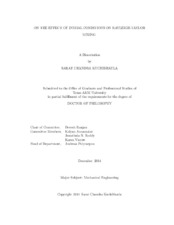| dc.contributor.advisor | Ranjan, Devesh | |
| dc.creator | Kuchibhatla, Sarat Chandra | |
| dc.date.accessioned | 2015-04-28T15:30:52Z | |
| dc.date.available | 2016-12-01T06:36:03Z | |
| dc.date.created | 2014-12 | |
| dc.date.issued | 2014-12-16 | |
| dc.date.submitted | December 2014 | |
| dc.identifier.uri | https://hdl.handle.net/1969.1/153932 | |
| dc.description.abstract | An experimental investigation of the effects of Initial Conditions (ICs) on Rayleigh-Taylor Instability (RTI) is performed using theWater Channel facility at Texas A&M University. Hot and cold water (with a temperature difference of ~ 5-8 °C) selected as working fluids are unstably stratified initially. The resulting Atwood number for this instability is of the order of 10^-3. In this dissertation, effect of the composition of the initial perturbations generated by a flapper mechanism is studied. Using the servo controlled flapper system, initial wavelengths are varied between 2-8 cm and phase angles within 0-180°, and the dependence of ensemble averaged mixing width in the linear and nonlinear stages of growth on low Atwood number Rayleigh-Taylor mixing is studied. The Interaction of multiple (up to 11) modes of the IC is studied by varying the wavelengths and phase angles that are generated at the interface of these fluids.
High resolution Planar Laser Induced Fluorescence (PLIF) images of the flow field indicate that changing the phase angle results in the leaning phenomenon, i.e. the leaning of bubbles and spikes with respect to gravitational acceleration, and relative to each other. Experimental measurement of total mixing width, quality of molecular mixing and scalar dissipation rate are performed using ensemble averaging technique. The results indicate that nonlinear mode coupling of the initial modes affects the rate of mixing as well as the transition to turbulence. Molecular mixing measurements indicate that the molecular mixing rate depends upon the ICs. Particle Image Velocimetry (PIV) data indicates that late-time velocity profiles of the mixing layer depend upon ICs. While the density power spectra indicate independence of ICs in the inertial range, the turbulent velocity statistics indicate that increasing the number of modes of the IC quickens the transition to turbulence. It also results in greater mixing, which reduces the density gradients as the flow evolves with time. Thus, the memory of the ICs is lost sooner with increasing number of initial modes. | en |
| dc.format.mimetype | application/pdf | |
| dc.language.iso | en | |
| dc.subject | Rayleigh-Taylor | en |
| dc.subject | Buoyancy | en |
| dc.subject | Mixing | en |
| dc.subject | Turbulence | en |
| dc.subject | PIV | en |
| dc.subject | PLIF | en |
| dc.subject | Initial condition | en |
| dc.subject | | en |
| dc.title | On the Effect of Initial Conditions on Rayleigh-Taylor Mixing | en |
| dc.type | Thesis | en |
| thesis.degree.department | Mechanical Engineering | en |
| thesis.degree.discipline | Mechanical Engineering | en |
| thesis.degree.grantor | Texas A & M University | en |
| thesis.degree.name | Doctor of Philosophy | en |
| thesis.degree.level | Doctoral | en |
| dc.contributor.committeeMember | Annamalai, Kalyan | |
| dc.contributor.committeeMember | Reddy, Junuthula N | |
| dc.contributor.committeeMember | Vierow, Karen | |
| dc.type.material | text | en |
| dc.date.updated | 2015-04-28T15:30:52Z | |
| local.embargo.terms | 2016-12-01 | |
| local.etdauthor.orcid | 0000-0002-9842-0999 | |


